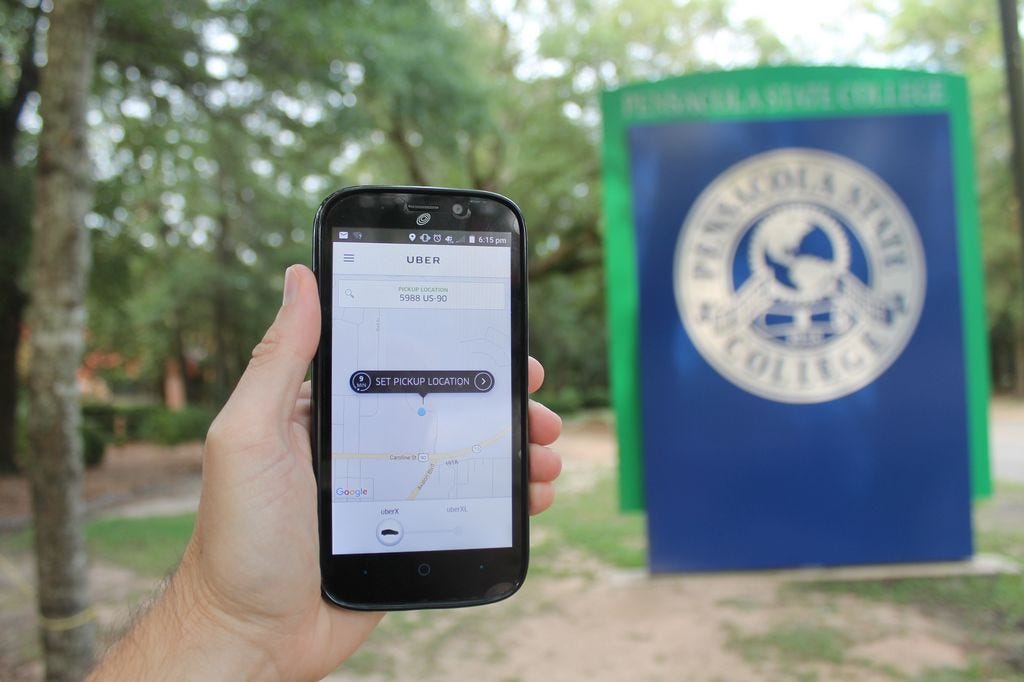
MILTON — Santa Rosa County’s current poverty rate is 45.57 percent.
Dr. Karen Barber, director of Federal Programs for the Santa Rosa County School District and president of Bridges Out of Poverty, said this number is also the percentage of enrolled students who qualify for free and reduced lunch.
The rate has risen from 41 percent, as reported in February 2014. Since then, Bridges, and community partners have been working to put in place public transportation, which a study determined was the greatest need of those in poverty.
The proposal includes:
●Uber for students
●Faith fleet for medical-related trips
●Expanding Escambia and Okaloosa County transportation into Santa Rosa County

UBER AND EDUCATION
Uber is a smartphone application that allows users to schedule and get rides, or be a driver for others using his or her vehicle. Through the app, the user sets the starting location, destination, and pays for the ride.
Milton’s Leadership Education Activities and Programs committee is working on a plan to have the city pay half of a student’s Uber ride to a post-secondary institution, according to Milton Planner Randy Jorgenson.
Jorgenson said lack of transportation “can end someone’s scholastic endeavors, and that’s in part what we’re trying to address.”
Paying for the program, Jorgenson said, would come from the city’s general fund at an estimated cost less than $10,000.
Jorgenson said the city would handle the cost of vouchers for student-riders while educational institutions would determine who’s eligible.
Dr. Anthea Amos, dean of the Pensacola State College Milton campus, said she’s excited about the possibility of students getting a partly paid ride to school.
“There are people who qualify; lots of them (such as those benefiting from a Pell grant) … they have a full ride (scholarship-wise) but no ride,” she said.
The program, Jorgenson said, would work with Locklin Technical Institute, but Principal Charlin Knight was unavailable for comment at the time of this writing.

FAITH FLEET
Pastor Brian Nall of Ferris Hill Baptist Church has been working with the faith community in Santa Rosa County to address transportation concerns, and has a tentative September launch date for the faith fleet.
“We’re just in the final part of recruitment and formalization,” he said.
Eligible passengers, Nall said, are “those who qualify for the transportation-disadvantaged program.”
Santa Rosa County’s paratransit serves medical and non-medical transportation services for those who cannot afford transportation.
Shawn Ward, the county’s transportation planner, said most funding for the service comes from Medicaid but the money tends to run out by the end of the month.
This is where the faith fleet steps in. Nall said if paratransit can’t provide a ride, or has run out of funding, the faith fleet could transport the passenger.
For now, the fleet focuses on medical transport, according to Nall, though he added, as the program moves forward and other churches offer to join, it could expand.

COUNTY TRANSPORTATION
Ward said he has been working with the Florida–Alabama Transportation Planning Organization, Escambia and Okaloosa counties, and Escambia County Area Transit and Okaloosa Transit cooperative on including Santa Rosa County routes in transit planning.
Those projects include an:
●Express route from State Road 281 (Avalon Boulevard) and S.R. 87 via Interstate 10 to Downtown Pensacola
●Express route from Milton via U.S. 90 to Downtown Pensacola
●Express route from Navarre via U.S. 98 to Hurlburt Field
“Escambia and Okaloosa counties are both working on the adoption of their Transit Development Plans,” Ward said. “TDPs are scheduled to be adopted in the next few months … Both TDPs will include and recommend the expansion of routes into Santa Rosa County.”
Ward said no proposed budgets or actions have been taken regarding Santa Rosa public transit, but following the adoption of the TDPs he will press ECAT and Okaloosa County staffers to work on cost estimates for “both express routes with limited stops and a fixed-route system utilizing multiple vehicles and stops.
“I will take the proposed estimates to the Santa Rosa County board of county commissioners at that point.”
Ward said SRC will still have to pay half the operating costs.
“We can get capital funding, federal and state, but it comes down to operating expenses. The county, accepting party, will have to pay 50 percent. Will that come from impact fees, sales tax, property tax?” he said.
“It’s up to the board of county commissioners to decide once we get cost estimates.”

Students with full scholarships could still lose their opportunity for education if they lack transportation to campus, area officials say. But area officials are working on solving that problem.
This article originally appeared on Santa Rosa Press Gazette: County, faith-based initiatives developing to help people who need rides
